ICSE Solutions for Class 7 History and Civics – Government, Society and Culture Under The Delhi Sultanate
ICSE SolutionsSelina ICSE SolutionsML Aggarwal Solutions
APlusTopper.com provides step by step solutions for ICSE Solutions for Class 7 History and Civics. You can download the History and Civics ICSE Solutions for Class 7 with Free PDF download option. History and Civics for Class 7 ICSE Solutions all questions are solved and explained by expert teachers as per ICSE board guidelines.
ICSE Solutions Class 7 History & CivicsGeographyMathsPhysicsChemistryBiology
Important Words
- Qazis administered justice according to the Islamic law, in cases that involved Muslims.
- Amir Khusrau was a famous Perisan poet who invented the Indian sitar.
- Qawwali is the Persian style of chorus singing which was popularized by Sufi saints.
- Kathak is a dance form which originated during the Sultanate period. It combines Hindu themes with Persian costumes.
Time To Learn
I. Fill in the blanks:
- The village administration was managed by Muqaddam.
- Firoz Shah Tughlaq made the Iqtdary system hereditary.
- Iqtdar received Iqtas.
- Firoz Shah Tughlaq arranged irrigation facilities for the farmers.
- The mixture of Persian and Hindu style in architecture is called Indo-Islamic style.
II. Match Column A with Column B:
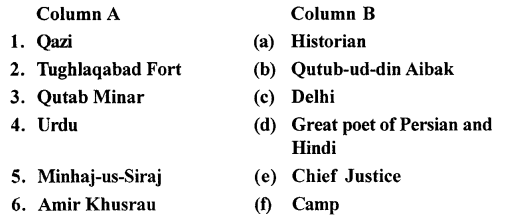
Answer:
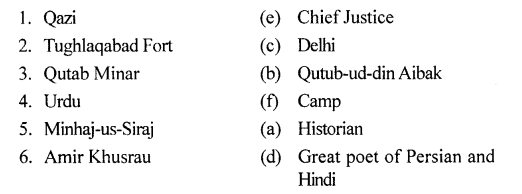
III. State whether the following statements are True or False:
- Urdu, a new language, developed in the Sultanate period.
True - The Sufi saints believed in one God.
False. - The Sultanate was a military rule.
True. - The village administration was managed by the Bakshi.
False.The village administration was managed by the Muqaddam. - The culture of the sultanate period saw healthy blending of Hindu and Muslim traditions.
True.
IV. Answer the following questions briefly:
Question 1.
How did the government function during the Sultanate Period?
Answer:
The government run under various departments. Each department was supervised by a minister or a high official.
The most important departments were:
- Diwan-i-wazarat or the revenue department headed by the Chief Minister called Wazir.
- Diwan-i-Arz or the military department headed by Ariz- i-Mumalik. It was the responsibility of this department to recruit, equip and pay the army.
- Diwan-i-Risalat dealing with religious matters, pious foundations and stipends to scholars. It was presided over by Chief Sadr also known as Chief Qazi. The Chief Qazi was the head of department of justice.
- Diwan-i-Insha dealt with all kinds of domestic as well as foreign correspondence.The village administration was managed by the Muqaddam. The Munsif supervised the accounts of the village while Patwari kept the local records.
Question 2.
What do you understand by Iqta system? How was this system organised?
Answer:
The system of granting revenue from a piece of land or a village to an officer instead of paying him a cash salary was called the Iqta system. Under this system, an officer (iqtadar) would collect the revenue from his territory (iqta). He would keep a certain amount of his salary from this revenue and another part of revenue was spent for maintaining the soldiers for the Sultan. They also had to.pay a fixed amount annually to the Sultan. The officer had to keep a detailed account of his income and expenditure.
Question 3.
How was society divided during the Sultanate period?
Answer:
The society during the Sultanate period was divided into-four main classes. The first or the aristocratic class was the most influential class in the society. This class consisted of the nobility and high officials. They were very rich and lived a luxurious life.The second important group were the Ulemas and the Hindu priests who advised the Sultan on how to carry on his administration in accordance with the sacred law.The third category of people or the town dwellers consisted of officials, merchants and artisans who were fairly well-to- do.The common people or the peasantry who formed the bulk of the population were poor and did not have enough to satisfy their needs.
Question 4.
Describe the important developments which took place in the following fields during the Sultanate period (a) Language (b) Music and (c) Dance.
Answer:
(a) Language: Persian was the language of administration and the nobility. Arabic was mostly used by traders from Western Asia. Sanskrit continued to be the language of high learning among the Hindus. The blending of Persian and Hindi, gave birth to a new language, Urdu. The word ‘Urdu’ means camp. It was the language used in camps by soldiers with different mother-tongues to communicate with each other.
(b) Music: During this time fusion of Perso-Arabic and Indian classical music styles were done and outcome of it was Hindustani Music. New musical instruments like the tabla, sitar and sarangi were also developed during this time. The Persian style of chorus qawwali was also popularized during this timer
(c) Dance: Kathak a dance form, originated during the Delhi Sultanate period. It combines Hindu themes with Persian costumes.
Question 5.
With examples explain how the Turks and the Arabs influenced the architecture of the Sultanate period.
Answer:
The characteristic feature of Sultanate architecture is the extensive use of bricks, arches, domes, beams and balconies. The Turkish monuments were plain. There was liberal use of floral and geometric designs. The use of red sandstone added colour to their buildings. Verses from the Koran were engraved on the walls of some buildings. Some of the important monuments of the Sultanate period are the Qutab Minar complex, the Alai Darwaza, the tomb of Ghiyasuddin Tughlaq, Firoz Shah Kotla, the Tughlaqabad for and the tombs of the Todi kings.
V. Picture study:
This is a picture of popular form of devotional music.
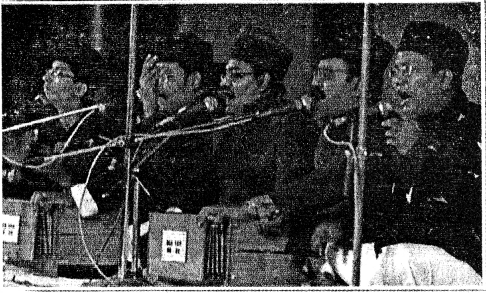
- What is the name of this form of music?
Ans. Qawwali performance. - Name the famous personality who created this.
Ans. Amar Khusrau. - What is the theme of the music?
Ans. Ghazal, a combination of beautiful poetry with melody, is also a contribution of the Sultanate period.
A. Fill in the blanks:
- The rule of the Delhi Sultans lasted for over three centuries.
- Society during the Sultanate period was divided into four major groups.
- The Turks introduced Arabic and Persian architectural styles.
- New musical instruments such as the tabla, sitar and sarangi were developed during the Sultanate period.
- The establishment of the Turkish rule in India led to the replacement of Sanskrit by Persian as the official language in many regions.
B. Match the following:


Answer:
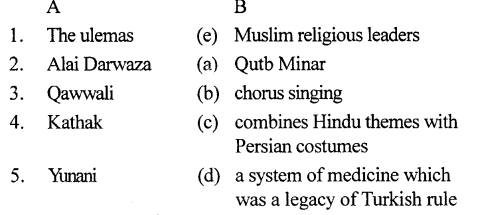
C. Choose the correct answer:
- Under the Delhi Sultanate, the aristocrats/the priests/ the peasants were the most powerful class in society.
Ans. Under the Delhi Sultanate, the aristocrats were the most powerful class in society. - The brahmanas/the ulema/the merchants were the chief advisors to the sultans.
Ans. The ulema were the chief advisors to the sultans. - The life of the peasants/the nobles/the priests was one of drudgery and poverty.
Ans. The life of the peasants was one of drudgery and poverty. - The caste system was followed strictly/sometimes followed/ignored by Hindus.
Ans. The caste system was followed strictly by Hindus. - Amir Khusrau is believed to have invented the harmonium/sitar/veena.
Ans. Amir Khusrau is believed to have invented the sitar.
D. State whether the following are true or false:
- The ruling class in the Delhi Sultanate enjoyed.a lavish lifestyle.
True. - The Delhi sultans always allowed the ulema to influence their policies.
False.
Correct : The Delhi sultans sometime does not allow the ulema to influence their policies. - The purdah system was strictly observed by Muslim women.
True.
- The Rajput style of miniature painting continued in the Sultanate period.
True.
- New types of food, such as bread and wine, became a part of Indian cuisine during the Sultanate period.
True.
E. Answer the following questions in one or two words/ sentences:
- Why was the aristocracy the most powerful social group during the Sultanate period?
Ans. Aristocracy was the most powerful social group because they had wealth and power. - What was the chief source of revenue for the government?
Ans. The tax paid by the peasants was the chief source of revenue for the government. - During whose reign did the life and conditions of the peasants improve?
Ans. During Firoze Shah’s reign peasants condition improved and they enjoyed many benefits. - Why did some Hindus convert to Islam?
Ans. Many Hindus, especially those belonging to the lower classes, were attracted to the Islamic tax, which was imposed only on non-Muslims. - How do we know that women during the Sultanate period were oppressed?
Ans. Sati, child marriage and the purdah system became widely prevalent. The purdah system was strictly observed by Muslim women. - What is the characteristic feature of Sultanate architecture?
Ans. The characteristic feature of Sultanate architecture is the extensive use of bricks, arches, domes, beams and balconies. - Which two styles of music influenced the development of Hindustani music?
Ans. Hindustani music was the outcome of the fusion of the Perso- Arabic and Indian classical music styles. - By whom were qawwalis popularized?
Ans. Qawwali is the Persian style of chorus singing which was popularized by Sufi saints. - Which style of painting was patronized by the Lodi sultans?
Ans. Persian style of miniature paintings was patronized by the later Lodi sultans and used to illustrate books. - How did the Turkish rulers gradually become Indianized?
Ans. When Turkish rulers married Indian Muslims, they assimilated many of their local cultural traits and gradually became Indianized.
F. Answer the following questions briefly:
Question 1.
What effect did several centuries of interaction between traditional Indian culture and Islamic culture have on the Indian society?
Answer:
The interaction between traditional Indian culture and Islamic culture had a deep impact on Indian society. This fusion resulted in a new pattern called Indo-Islamic culture.
Question 2.
Describe the main features of society during the Sultanate period with reference to (a) the aristocracy and (b) the peasants.
Answer:
(a) Aristocracy: This was the ruling class. It consisted of the Sultan, the nobles, the Hindu rajas and princes and landlords. This was the most powerful social group because they had wealth and power.
(b) Peasants: The peasants during that time were very poor and they had to lead a very hard life. They had to do all kind of small jobs and had to pay heavy taxes to government.
Question 3.
Discuss the distinctive features of Sultanate architecture.
Answer:
The characteristic feature of Sultanate architecture is the extensive use of bricks, arches, domes, beams and balconies. The Turkish monuments were plain. There was liberal use of floral and geometric designs. The use of red sandstone added colour to their buildings. Verses from the Koran were engraved on the walls of some buildings. Some of the important monuments of the Sultanate period are the Qutb Minar complex, the Alai Darwaza, the tomb of Gbiyasuddin Tughlaq, Firoz Shah Kotla, the Tughlaqabad for and the tombs of the Lodi kings.
Question 4.
Music and dance during the Sultanate period was the outcome of the fusion of Indo-Islamic culture. Explain.
Answer:
Indian or Hindustani music was the outcome of the fusion of the Perso-Arabic and Indian classical music styles. New musical instruments such as the tabla, sitar and sarangi were developed during this time. “The famous Persian poet, Amir Khusrau, is believed to have inveted the sitar by combining the South Indian veena with the Persian tanpura. The South Indian drum was probably altered to create the table. ‘The Persian style of chorus singing, known as qawwali, was popularized by the Sufi saints, a group of Muslim mystics, who became popular during this period. They sang devotional songs at their religious meetings.Kathak, a new dance form that also developed during this time, combines Hindu themes with Persian customes.
Question 5.
Explain how new customs and practices changed the traditional lifestyle of the Indians.
Answer:
New customs and practices changed the traditional lifestyle of the Indians. Hindus and Muslims wore pyjama-kurtas, kaftans and salwar-kameez and continue doing so to this day. New types of foods such as biryani, bread and wine became a part of Indian cuisine.
G Picture study:
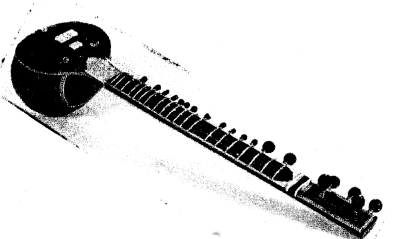
This is a picture of a musical instrument used in Hindustani classical music. The name is derived from the Persian words—‘seh’ (meaning ‘three’) and tar’ (meaning ‘strings’).
Answer:
- Identify the muscial instrument.
Ans. Sitar. - During which period in medieval Indian history was this instrument invented?
Ans. During Delhi Sultanate. - By whom and how was it invented?
Ans. AmirKhusrau. - Name two other musical instruments that were developed during this period
Ans. Tabla, Sarangi.